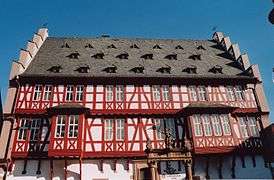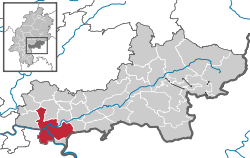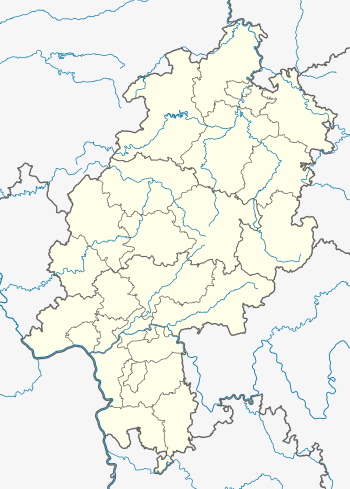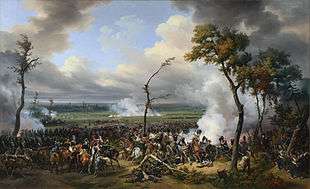Hanau
Hanau [ˈhaːnaʊ̯] is a town in the Main-Kinzig-Kreis, in Hesse, Germany. It is located 25 km east of Frankfurt am Main and is part of the Frankfurt Rhine-Main Metropolitan Region. Its station is a major railway junction and it has a port on the river Main, making it an important transport centre. The town is known for being the birthplace of Jakob and Wilhelm Grimm and Franciscus Sylvius. Since the 16th century it was a centre of precious metal working with many goldsmiths. It is home to Heraeus, one of the largest family-owned companies in Germany.
Hanau | |
|---|---|
 Goldsmiths' House (Hanau old town hall) | |
 Coat of arms | |
Location of Hanau within Main-Kinzig-Kreis district  | |
 Hanau  Hanau | |
| Coordinates: 50°07′58″N 08°55′01″E | |
| Country | Germany |
| State | Hesse |
| Admin. region | Darmstadt |
| District | Main-Kinzig-Kreis |
| Government | |
| • Lord Mayor | Claus Kaminsky (SPD) |
| Area | |
| • Total | 76.49 km2 (29.53 sq mi) |
| Elevation | 104 m (341 ft) |
| Population (2018-12-31)[1] | |
| • Total | 96,023 |
| • Density | 1,300/km2 (3,300/sq mi) |
| Time zone | CET/CEST (UTC+1/+2) |
| Postal codes | 63450, 63452, 63454 63456, 63457 |
| Dialling codes | 06181 |
| Vehicle registration | HU |
| Website | www.hanau.de |
Hanau, once the seat of the Counts of Hanau, lost much of its architectural heritage in World War II. A British air raid in 1945 created a firestorm, killing one sixth of the remaining population and destroying 98 percent of the old city and 80 percent of the city overall.
In 1963, the town hosted the third Hessentag state festival. Until 2005, Hanau was the administrative centre of the Main-Kinzig-Kreis. On 19 February 2020, a gunman attacked two hookah lounges in Hanau, murdering nine people with roots outside Germany, before shooting his mother and himself.
Geography
The historic core of Hanau is situated within a semicircle of the river Kinzig which flows into the river Main just west of the town. Today, after a substantial expansion during the 19th and 20th centuries it also extends to the river Main and after a restructuring of municipal borders within Hesse in the 1970s a couple of nearby villages and towns were incorporated. After this change, Hanau for the first time also extended to the south bank of the Main river.
Climate
On the 0 °C isotherm, Hanau has a humid continental climate as Eastern Germany with warm summer, classified by Köppen as Dfb. In the -3 °C isotherm has oceanic climate (Cfb) with some interior characteristics. Using the first definition used is the city most west of the continent below 200 m at sea level with this category.[2]
| Climate data for Hanau | |||||||||||||
|---|---|---|---|---|---|---|---|---|---|---|---|---|---|
| Month | Jan | Feb | Mar | Apr | May | Jun | Jul | Aug | Sep | Oct | Nov | Dec | Year |
| Record high °C (°F) | 13 (55) |
18 (64) |
26 (79) |
30 (86) |
33 (91) |
35 (95) |
36 (97) |
36 (97) |
31 (88) |
27 (81) |
20 (68) |
16 (61) |
36 (97) |
| Average high °C (°F) | 3 (37) |
5 (41) |
10 (50) |
14 (57) |
19 (66) |
22 (72) |
24 (75) |
24 (75) |
19 (66) |
14 (57) |
8 (46) |
4 (39) |
14 (57) |
| Average low °C (°F) | −2 (28) |
−1 (30) |
2 (36) |
4 (39) |
8 (46) |
11 (52) |
13 (55) |
12 (54) |
9 (48) |
5 (41) |
2 (36) |
−2 (28) |
5 (41) |
| Record low °C (°F) | −20 (−4) |
— | −12 (10) |
−5 (23) |
— | 3 (37) |
4 (39) |
2 (36) |
1 (34) |
−2 (28) |
−9 (16) |
— | −20 (−4) |
| Average precipitation mm (inches) | 30 (1.2) |
30 (1.2) |
30 (1.2) |
40 (1.6) |
50 (2.0) |
70 (2.8) |
50 (2.0) |
50 (2.0) |
50 (2.0) |
30 (1.2) |
50 (2.0) |
50 (2.0) |
530 (21.2) |
| Average snowfall cm (inches) | 9 (3.5) |
10 (3.9) |
4 (1.6) |
trace | 0 (0) |
0 (0) |
0 (0) |
0 (0) |
0 (0) |
0 (0) |
6 (2.4) |
10 (3.9) |
46 (18) |
| Average rainy days | 10 | 8 | 8 | 9 | 10 | 10 | 10 | 10 | 8 | 8 | 10 | 10 | 111 |
| Average snowy days | 4 | 3 | 1 | 1 | 0 | 0 | 0 | 0 | 0 | 0 | 1 | 3 | 13 |
| Average relative humidity (%) | 89 | 84 | 85 | 82 | 80 | 80 | 81 | 84 | 89 | 91 | 89 | 90 | 85 |
| Mean daily sunshine hours | 1 | 3 | 4 | 6 | 7 | 7 | 7 | 6 | 5 | 3 | 1 | 1 | 4 |
| Source: WeatherBase and Fremdenverkehrsbuero.info (temperature, rainy and sunny days) | |||||||||||||
Districts
- Innenstadt (town center)
- Nordwest (northwest) incl. Wilhelmsbad
- Südost (southeast)
- Lamboy
- Steinheim
- Klein-Auheim (Hanau)
- Großauheim
- Wolfgang
- Kesselstadt
- Mittelbuchen
Name
The name is derived from "Hagenowe", which is a composition of Haag (wood) and Aue (open land by the side of a river).
History

.png)
Old town
As a place of settlement Hanau was first mentioned in 1143. Formerly it was the site of a castle which used the waters of the river Kinzig as a defense. The castle belonged to a noble family, calling themselves "of Hanau" since the 13th century. Starting from this castle a village developed and became a town in 1303. As a result of this history, the main church of Hanau stood outside its walls in the village of Kinzdorf. The villagers moved into the town, Kinzdorf became an abandoned village leaving only the church. Only in the 15th century was the status of the Hanau parish church transferred to the church of Mary Magdalene within the town walls.
Shortly after the first town walls were built at the beginning of the 14th century, the town outgrew this limit. Outside the wall, along the road to Frankfurt am Main a settlement developed (the Vorstadt) which was properly included in the fortifications of Hanau only when Hanau received completely new fortifications in Renaissance-style during the first half of the 16th century. These new fortifications enclosed three elements: The medieval castle, the medieval town of Hanau and the Vorstadt.
New town
At the end of the 16th century, Count Philipp Ludwig II attracted Protestant refugees from the Netherlands and France to found their own settlement south of Hanau.[3] This was of high economic interest for him because these Walloons brought high-class trade, their knowledge of jewellery and other production of luxury items and therefore taxes to his county. Out of this tradition, goldsmiths are still trained in Hanau. Hanau also was the site of the first workshop to produce Faience within Germany. These new citizens were granted privileges and they formed their own community, church and administration for the "new town of Hanau" (Neustadt Hanau) wholly separate from the existing community. It took more than 200 years to amalgamate both. The new town – larger than the old one – was protected by a then very modern fortification in Baroque-style which proved a big asset only a few years later in the Thirty Years' War. The town survived a siege in 1637 with only minor damage.
The new citizens formed the major economic and political power within the County of Hanau and in 1642 played a leading role in the succession of Count Fredrik Casimir of Hanau Lichtenberg into the County of Hanau-Münzenberg of which the town of Hanau was the capital.
In 1736 Johann Reinhard III of Hanau-Lichtenberg, the last of the Counts of Hanau, died. Those parts of his county belonging to the County of Hanau-Münzenberg, which included Hanau, were inherited by the Landgrave of Hesse-Kassel. Due to dynastic troubles within this family the County of Hesse-Hanau was created a separate state from the Landgraviate until 1786. So Hanau stayed capital for another 50 years. Even after that it became – after Kassel – the town second in importance within Hesse-Kassel.
17th century
During the Thirty Years' War Hanau was taken by the Swedes in 1631.[3] In 1636 it was besieged by the imperial troops, but was relieved on the 13th of June by William V, Landgrave of Hesse-Kassel, on account of which the day is still commemorated by the inhabitants.[3]
19th century

During the Napoleonic Wars the Emperor himself ordered the fortifications of Hanau to be destroyed. This created a chance for both parts of the town to expand across their traditional limits. In 1813, the Battle of Hanau took place near the city between French troops and Austro-Bavarian forces. During the 1820s the administrations of both towns of Hanau were merged. The first common Mayor, who became Lord Mayor (Oberbürgermeister) was Bernhard Eberhard, later to become prime minister and minister of the interior of the Electorate of Hesse after the Revolution of 1848.
With its pre-industrial workshops Hanau became a nucleus of a heavy industrialisation during the 19th century: From within the city (e.g.: Heraeus) as well as from outside (e.g. Degussa, Dunlop). This was heavily supported by its development as an important railway interchange of six railway lines, most of them main lines:
- 1848: Frankfurt-Hanau Railway
- 1854: Main–Spessart Railway
- 1867: Frankfurt–Bebra Railway, eastern direction
- 1873: Frankfurt–Bebra Railway, western direction
- 1879/1881: Friedberg–Hanau Railway
- 1882: Odenwald Railway
In the 19th century, Hanau was a centre of the German democratic movement and contributed significantly both in 1830 and in the Revolution of 1848. As part of this movement the German Gymnastic League (Deutscher Turnerbund) was founded here in 1848. Hanau was finally annexed to Prussia like all of Hesse-Kassel in 1866 after its Prince-elector took the Austrian side in the Austro-Prussian War. It remained part of Prussia until 1945.
In the late 19th century Hanau became a major garrison town. Due to its interchange of railway lines a large detachment of military railway-engineers as well as other military units were stationed here.
20th century
During World War II, the Jewish population were persecuted with the last Jews being deported in May 1942.
Hanau was for the most part destroyed by British airstrikes in March 1945 a few days before it was taken by the U.S. Army. Around 87% of the town was destroyed.[4]:35 Of 15,000 inhabitants who remained in the city at the time, 2,500 died in the attack.
The town housed one of the largest garrisons of the U.S. Army in Europe. Being an important strategic location in the so called Fulda Gap, the military community had a population of 45,000 military members, U.S. civilians and family members at its peak during the Cold War. The extensive U.S. facilities included Hanau Army Airfield, also known as Fliegerhorst Langendiebach. The garrison was closed in April 2018. Most of the former military areas have been converted to civil use in the meantime.
21st century
In 2010, Hanau started a huge building project to completely redesign the inner city. These are the largest construction works in the town since the reconstruction after World War II.
On 19 February 2020, eleven people—including the perpetrator—were killed in a spree shooting at two shisha bars and a flat in the town.[5] The perpetrator, known as Tobias Rathjen, opened fire at Midnight Bar and Arena Bar in Hanau centre and Kesselstadt. Tobias then drove home, where he killed his mother, and shot himself.
Economy
At present, many inhabitants work in the technological industry (VAC, Heraeus) or commute to Frankfurt. Frankfurt International Airport is 30 km away.
Population
- With a population of 98,438 it is the sixth most populous town in Hesse. Having lost its status as administrative centre of the Main-Kinzig-Kreis (Main-Kinzig district) to Gelnhausen in 2005, proposals have been made that Hanau should form its own administrative district by 1 April 2021.
- More than 20% of the inhabitants are foreign nationals, mostly Turkish workers.
| Largest groups of foreign residents | |
| Nationality | Population (2011) |
|---|---|
| 8,010 | |
| 1,917 | |
| 943 | |
| 647 | |
| 560 | |
| 560 | |
Jewish community
The earliest documentary evidence for the presence of Jews in Hanau dates from 1313. In the 17th and 18th centuries Hanau developed into an important center of Hebrew printing. The community numbered 540 persons 1805, 80 families in 1830, 447 persons in 1871, and 657 at the turn of the century. In 1925 there were 568 Jews in Hanau.[6]
International relations
Hanau is twinned with:[7]







In addition it is associated with two other towns:


Transport
Rail
Hanau is a transportation hub in Germany, with its main station serving the following lines:
- Frankfurt-Hanau Railway (RE / RB 55),
- Main-Spessart-Bahn (from Hanau to Aschaffenburg Hauptbahnhof) (RE / RB 55),
- Kinzig Valley Railway to Fulda (RE / RB 50),
- Frankfurt-Bebraer railway (westbound) to Offenbach Hauptbahnhof, Frankfurt am Main Hauptbahnhof as well as the largely parallel south metropolitan S-Bahn,
- Friedberg-Hanauer railway (RB 33) and
- Odenwaldbahn (RE / RB 64) towards Babenhausen, Groß-Umstadt-Wiebelsbach, Erbach and Eberbach.
Besides the main station, the town is also served by Hanau West and Hanau-Wilhelmsbad on the Frankfurt-Hanau Railway, Großauheim on the Main-Spessart-Bahn, Wolfgang an der Kinzigtalbahn, the S-Bahn station at Steinheim (Main) on the South-Main S-Bahn, Hanau Nord at the Hanau-Friedberger Bahn and Hanau-Klein Auheim on the Odenwaldbahn.
Sights
- Deutsches Goldschmiedehaus
- Schloss Philippsruhe
- Wilhelmsbad (historic spa)
- Marienkirche (Hanau) (St Mary's Church)
- Wallonisch-Niederländische Kirche
 Historic spa of Wilhelmsbad - today a part of Hanau
Historic spa of Wilhelmsbad - today a part of Hanau Schloss Philippsruhe
Schloss Philippsruhe Lion at Schloss Philippsruhe by Christian Daniel Rauch
Lion at Schloss Philippsruhe by Christian Daniel Rauch Amphitheater Hanau
Amphitheater Hanau
Notable people

- Louis Appia, surgeon, member of the Geneva "Committee of Five" (precursor to the International Committee of the Red Cross)
- J. C. C. Devaranne was born in Hanau on 8 March 1784
- Siegmund Feniger, also known as Nyanaponika Thera, Buddhist monk
- Jürgen Grasmück, author of horror fiction and science fiction stories, born in Hanau in 1940.
- The Brothers Grimm (Brüder Grimm) collected many German fairy tales and started work on the German Glossary
- Ludwig Emil Grimm, painter, younger brother of Jacob and Wilhelm
- Solomon Hanau, 17th century Hebrew-language linguistic master
- Hans Daniel Hassenpflug, German statesman
- Paul Hindemith, composer
- Stefan Jagsch, extreme-right politician
- Alois Kottmann, (*1929) violinist, was born in Großauheim
- Johann Peter Krafft, painter (1780-1856)
- Moritz Daniel Oppenheim, painter, often regarded as the first Jewish painter of the modern era.
- Karl Storck, Romanian sculptor, born in Hanau on 30 March 1887
- Hermann Volk (1903-1988), Roman-catholic bishop in Mainz
- Rudi Völler, football/soccer world champion 1990 and coach of the German national team, when it was runner-up in 2002
- Wilhelm Wagenfeld, Designer (1900–1990)
Sports
- Turngemeinde 1837 Hanau a.V. (TGH), one of the oldest of Germany's sports clubs
- Hanauer Rudergesellschaft 1879 e.V. (HRG), one of Germany's oldest rowing clubs
- 1. Hanauer FC 1893 e.V. (Hanau '93), Hesse's oldest association football club
References
- "Bevölkerungsstand am 31.12.2018". Hessisches Statistisches Landesamt (in German). July 2019.
- "Updated Köppen-Geiger climate map of the world". people.eng.unimelb.edu.au. Retrieved 2018-12-19.
- Chisholm, Hugh, ed. (1911). . Encyclopædia Britannica. 12 (11th ed.). Cambridge University Press. p. 908.
- Schumacher, Karin; Schumacher, Hans-Jürgen (2003). Zeitreise durch den Spessart (German). Wartberg Verlag. ISBN 3-8313-1075-0.
- "Germany: Eleven dead in suspected far-right attack | DW | 20.02.2020". DW.COM. Deutsche Welle.
- "Hanau". Museum of The Jewish People - Beit Hatfutsot. Retrieved 2019-07-21.
- "Internationale Beziehungen". hanau.de (in German). Hanau. Retrieved 2019-11-29.
External links


- Official town website (in German)
- HanauOnline Webzine (in German)
- Staatliche Zeichenakademie Hanau (Hanau State Academy) (in German)